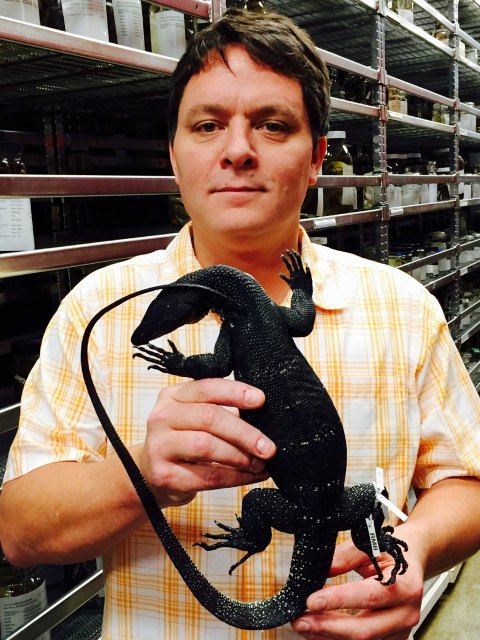Undercover researchers: Never-before-seen lizards for sale in Philippines
(Second of two articles)
MANILA, Philippines — A team of undercover researchers based in Kansas discovered two species of water monitor lizard that were previously unknown to science being sold in the Philippines.
"Over a five-year period we visited pet markets, roadside bush-meat stands and various other markets where monitor lizards were sold as pets or meat," said Rafe Brown, curator-in-charge of the herpetology division at the University of Kansas' (KU) Biodiversity Institute.
"We used to walk around pet markets and side streets talking to traders using circuitous conversation and eventually getting around to asking them if they had 'anything else' behind the scenes or in the back room," he added.
Often, sellers would offer Brown and his fellow researchers "a turtle or monitor lizard or some other animal which they should not have had in their possession," he said.
The team purchased the reptiles to genetically analyze them at KU in an effort to help Philippine police and conservationists.
Brown said they hope to build genetic databases to serve as enforcement references for confiscated animals "to empower local enforcement officials with the forensic, scientific and legal means."
"We were aware that traders routinely mislead buyers with fantastic stories of animals' origins to fetch a higher price, so we reasoned that genetic methods could pinpoint an animal's origins when a trader's account was not to be trusted," he said.
This was when the researchers found genetic varieties of water monitor lizards that differed sharply from those common to areas surrounding Manila.
Brown said that the discovery was a sign that additional species diversity might exist, hidden within northern Philippines' water monitor lizard population.
The scientist said the two kinds of animals are "gorgeous" with bodies of either black and white or black and yellow.
"They are dark in general appearance with bright speckling of white or yellow spots arranged in rows and stripes around the body, as if wearing shining necklaces," Brown said.
"One gets up to a little over three feet in length, and the other is somewhat larger at about four feet. They're monitor lizards, so they're alert, with large eyes, continually flicking long tongues, which they 'smell' with, and they're generally very alert and look quite intelligent," he added.
'Cryptic'
Brown and colleagues, Luke Welton from Brigham Young University, Cameron Siler from the University of Oklahoma and Mae Diesmos from the University of Santo Tomas returned to KU to sequence the mitochondrial and nuclear DNA of the monitor lizard species.

Scientist Rafe Brown holds a Varanus bangonorum specimen. KU News Service
They found the two lizards were "morphologically cryptic," meaning they looked much like known species of monitor lizard, but their genetic variation indicated they were evolutionarily distinctive, qualifying them as unique species.
The researchers named the lizards Varanus dalubhasa and Varanus bangonorum.
Brown explained conservationists had overlooked the lizards because they were considered to be the same as another, widespread species. But now, the two new species are becoming a priority for conservation efforts.
"They were confused with species that were physically very similar in scale numbers, shapes, color patterns and body size," he said.
"But even though they looked similar, it now makes perfect sense to us in hindsight that they should be distinct and considered separate species because they come from different areas — a separate island in one case and an isolated peninsula in another. Both have been isolated for considerable geological time," Brown explained.
The National Science Foundation funded this work. The Philippine Biodiversity Management Bureau and the KU Biodiversity Institute supported Brown and his students throughout the lengthy period that it took to complete the undercover research. Other team members included Arvin Diesmos, Emerson Sy and Vicente "Enteng" Yngente.
ALSO READ: US research team: Exotic species sold in Philippines' black market
---
This story is contributed by the University of Kansas News Service and revised for publishing by Philstar.com.
- Latest
- Trending































